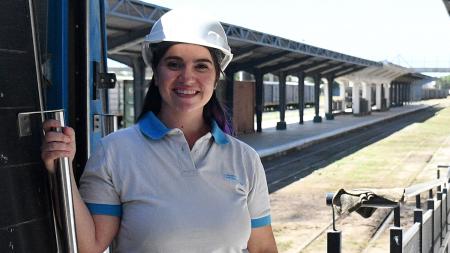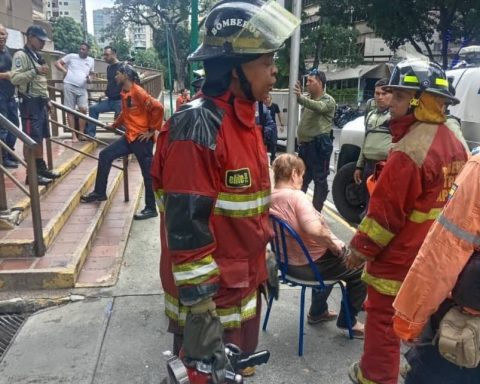The land transport category, despite having barely 7% of their jobs held by women, It stood out in recent years for having incorporated gender policies to improve current working conditions and encourage the participation of more female workers.
At the end of 2021, jobs in the land transport sector totaled 310,644spread over 29,782 companies.
Of that total, 20,666 were women (7%)while the remaining 93% (289,978) were occupied by men, according to the latest data from the National Ministry of Labour, Employment and Social Security.
This sector includes urban and suburban automotive transport services for merchandise and animals with 141,013 positions -132,018 men and 8,995 women-; automotive passenger transport with 51,274 jobs -46,982 men and 4,292 women-; and other transport services such as school, freight and removals, with 3,948 jobs (3,564 developed by men and 484 by women).
By provinces, the largest number of female workers in the sector is registered in Buenos Aires (38%), followed by the Autonomous City of Buenos Aires (19%) and Córdoba (8%).
With regard to cargo transportation, the total number of jobs is around 95,000 positions at the country level, of which 83% are occupied by men and 17% by women.
The Argentine Federation of Cargo Trucking Business Entities (Fadeeac) -which brings together 44 transport chambers from all over the country- has the Women and Future Leaders Department that seeks to make women entrepreneurs visible in the sector, offering professional driving courses to professionalize the activity.
Within this framework, from 2015 to date, 109 women have been trained in the courses of the Professional Foundation for Transportation (FPT).
Of this total, 60% took the Professional Driving Course (CCP); 40% for Forklift Operator; 25% participated in the regulatory courses and 5% in the annual license renewal.

The president of FPT, Aníbal Goichik, in dialogue with Télam, said that the commemoration of 8M “is a date to reflect on and value the achievements made by women in the cargo transportation sector.”
“We know that we still have many challenges ahead and we are committed to continue building the path to achieve a more inclusive sector,” added the manager.
For his part, In the railway and subway sector, both cargo and passenger – always based on 2021 data – the total number of positions was 39,543, of which 5,096 were women and 34,447 were men.

The action of the CNRT
In the case of the National Transport Regulation Commission (CNRT), the body continues to incorporate different gender and diversity policies, in line with the actions and joint work with the Ministry of Transport of the Nation and the Ministry of Women, Gender and Diversity.
The CNRT has a technical team made up of four members from different sectors who work in the organization giving talks on Gender Violence and Workplace Violence.
Added to this are references in the Commission for Equal Opportunities and Treatment, which works together with a guidance team to provide containment and assistance in cases of gender violence.
The presence of women in the subways
Regarding the subway network and the Premetro in the City of Buenos Aires, the number of people who work under the agreement is 3,721.
Of the total number of women who work in this sector, which add up to about 1,200 under various forms of contract, 352 work in the traffic area; 341 in stations; 174 as guards; 164 are drivers; 150 in cleaning; and 15 are the maneuvering area.
Subway transportation and Premetro is one of the highlights in regards to the presence of working women, from a collective organization that began to face the inequalities historically raised in the field.
“Until that moment, women were exclusively conditioned to historically feminized tasks, customer service, receiving the lowest remuneration, establishing a marked occupational segregation without the possibility of access to other tasks or categories and without opportunities for promotions,” she told Télam. Karina Nicoletta, Secretary of Gender of the Trade Union Association of Subway and Premetro Workers.
Initially, the main initiatives sought to “make visible problems such as dialogue with colleagues, participation in public and institutional spaces, presentation of petitions with signatures, or even complaints of discrimination that they suffered before job applications,” he explained.
“With these small actions we achieved a historical fact that was to incorporate guards who entered by competition, reaching leadership and directive positions today, under equal conditions,” Nicoletta stressed.
Currently, In subways and pre-metro, there are women workers in practically all sectors and in different areas, the union leader remarked.
As an example, Nicoletta cited the entry of the first batch of women into the night shift at the end of 2019, a time when only men used to work.
Life story: Daiana Perrotta, the first woman with a license to drive on the railway
Daiana Perrotta is 33 years old, is a civil engineer and started working in the railway sector from an internal search carried out by the Roca Line at the university level, inspecting civil works contracted by outsourced companies.
“When I started looking for a job in the railway sector, they asked for a requirement to be men, have a technical degree or experience. Since I did not have those requirements, I entered the field through an internship, which helped me to realize the magnitude of the sector and how interdisciplinary it is,” said Perrota in dialogue with Télam.
Two years after the initial experience, at Daiana received an application to be in charge of infrastructure in the province of Córdobaa position for which his partner also applied.
Although she did not stay in the position and her husband did, she was offered to be an inspector of what in railway jargon is called “works of art”, she ended up with what they usually refer to as the inspection of bridges, culverts, drains or areas of difficult access that are generally traveled by train.
The inspection included railway circuits in the provinces of Córdoba, Chaco, Entre Ríos, Salta and Neuquén.
“In Buenos Aires this is not very noticeable because it is quite populated and they are all urban lines. But in Córdoba and in other provinces there are sectors that are not in urban areas such as mountains in Salta or sierras in the case of Córdoba. For this reason, I continued my training and took a course for foremen and road operators that enables me to drive self-propelled vehicles on roads, becoming the first woman to have a license in this area to drive,” she explained.
In his case, this historic event in the field was a professional matter because “I had to fulfill my professional task and I needed to access this course.”
“Trains is a very large company and at the same time it is interdisciplinary, which is why I found it very interesting because you have to have contact and knowledge with other areas. My work is essential for the organization and route of the trains,” he stressed.
Regarding the gender issue, Perrotta said that he found different situations regarding the participation of women on trains.
“When I started working in Buenos Aires at Roca, it happened to me that there were a lot of professional women in the area but when I came to Córdoba I began to notice what it was like to be a woman because the people I worked with weren’t used to it, some didn’t know how treat me, talk to me and they even felt uncomfortable. Over time they understood that we are all on the same team and that being a woman did not condition my work or harm that of others,” she said.
Regarding his daily routine, Perrota said that there are days when he reveals railway works with his spreadsheets, reviewing certain parameters of the works, while on other days he must travel with the vehicles to the different areas through which the trains pass to check that everything works correctly.
“The road is being covered to identify problems in metal bridges, pipes, or vehicular crossings. Then this information is transferred to forms to record what work is required. I am also in charge of controlling the bidding processes of outsourced companies and notifying the different areas the services affected by them,” he said.
Its task also includes the need to “reach an agreement with the municipalities, traffic agents, carry out procedures, authorizations, along with monitoring of each work and construction”, for the completion of the tasks.
“In order for there to be more and more women, it is necessary to expand the jobs regardless of gender and for this situation to normalize in the different spaces. We must not close ourselves to the fact that a position has to be made up of a man with certain characteristics but rather a trained person that nourishes the company and allows each woman to grow professionally doing what she is passionate about”, concluded Perrota.


















